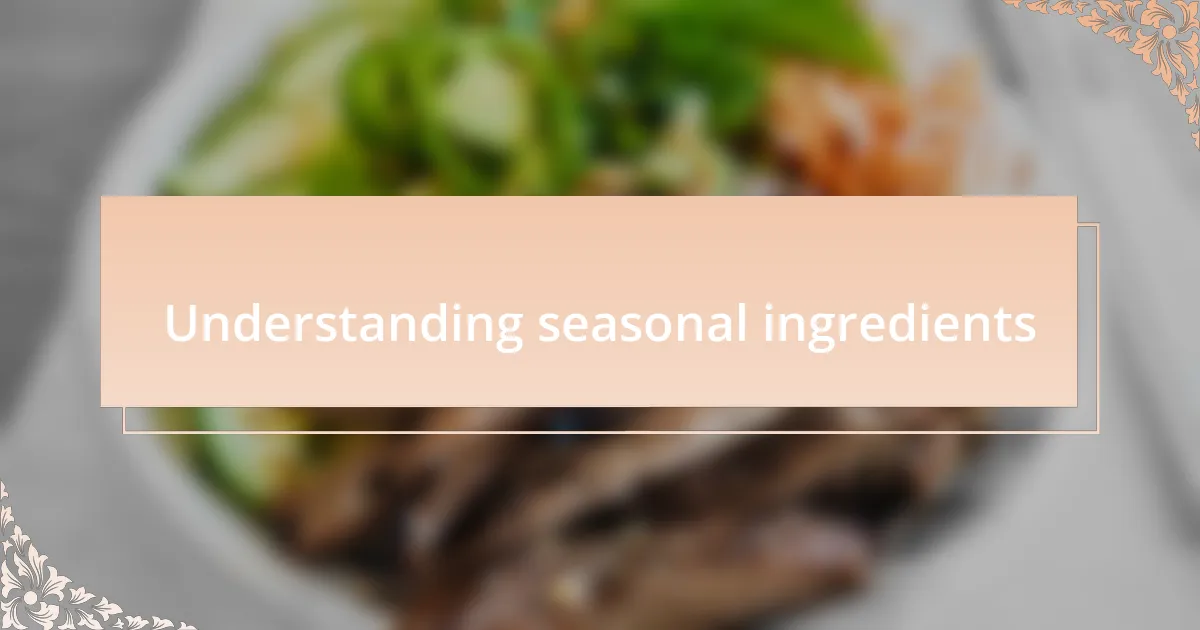Key takeaways:
- Seasonal ingredients enhance flavor and foster community connections through shared meals and experiences.
- Cooking with seasonal produce promotes sustainability and supports local agriculture, reducing the carbon footprint.
- Planning menus around seasonal themes allows for creative expression and deeper appreciation of each season’s unique offerings.
- Daily incorporation of seasonal flavors enriches meals and evokes nostalgia, creating personal connections through food.

Understanding seasonal ingredients
Understanding seasonal ingredients is like tuning into nature’s rhythm. I remember the first time I visited a local farmer’s market in spring; the vibrant greens and the scent of fresh herbs completely captivated me. It struck me how these seasonal offerings not only support local agriculture but also encourage a more sustainable way of cooking.
When I think about the flavors of summer, juicy tomatoes and sweet corn come to mind. There’s something truly special about incorporating these ingredients into my dishes at their peak ripeness. Have you ever tasted a heirloom tomato salad with a drizzle of balsamic reduction? It’s a game changer. Cooking with seasonal ingredients allows me to highlight their unique characteristics while fostering a deeper connection with the seasons.
In the fall, the arrival of pumpkins and squash makes me feel excited about hearty, warming meals. It’s fascinating how certain ingredients evoke nostalgia and inspire creativity in the kitchen. Isn’t it remarkable how the changing seasons influence not just what we eat, but also how we feel? Embracing these ingredients fosters a sense of community and belonging, reminding us of the beauty in cycles of nature.

Benefits of seasonal cooking
Cooking with seasonal ingredients has profound benefits, one being the enhancement of flavor. I still recall making a dish with freshly harvested strawberries in the late spring. The sweetness and juiciness far exceeded anything I’d tried from the grocery store. Doesn’t that make you wonder how much more flavor we miss when we rely on out-of-season produce?
Another significant advantage is sustainability. By selecting what’s in season, I feel like I’m reducing my carbon footprint. I often reflect on my visits to local farms; knowing I’m supporting farmers who use eco-friendly practices adds a deeper meaning to my meals. When was the last time you considered where your food comes from and how it impacts the environment?
Seasonal cooking also connects me to my community. I find joy in sharing recipes that highlight the best of what’s available. Last fall, I hosted a small gathering featuring a menu crafted around local winter vegetables. It was incredible to see how excited my friends were to taste familiar flavors in new ways. Isn’t it wonderful how food can bring people together and create lasting memories?

How to source seasonal ingredients
Finding seasonal ingredients isn’t just about shopping—it’s about building relationships. I’ve developed a routine of visiting local farmers’ markets each week, chatting with vendors, and discovering what’s fresh and vibrant. Have you ever tasted a ripe peach that was picked just hours before? There’s an unmatched joy in knowing where your food comes from and forming that connection.
I also keep a close eye on local farms’ harvesting schedules. One memorable spring, I contacted a nearby organic farm to inquire about their avocado and herb production. When I received an email with a list of what was ripe for picking, I felt that thrilling sense of anticipation, like preparing for a mini-adventure in my kitchen. Isn’t it exciting to plan a dish around ingredients that are at their peak freshness?
Additionally, seasonal cooking encourages me to embrace creativity. When I find an abundance of a certain vegetable, I challenge myself to use it in various ways. Just last winter, when squash was abundant, I transformed it into soups, salads, and even a dessert! It’s a satisfying puzzle, and I often wonder: how can I make the most of what’s in season? This exploration brings an element of fun into my cooking routine, making each meal a delightful experiment.

Planning menus with seasonal themes
Planning menus with seasonal themes allows me to celebrate the unique flavors each season offers. I remember one summer when I crafted a brunch menu featuring vibrant heirloom tomatoes, basil, and fresh mozzarella. The burst of flavors in a caprese salad was so refreshing that I could almost feel the sunshine with every bite.
In the fall, I shift gears to incorporate warm spices and heartier ingredients. Last October, I focused my menu around pumpkin and apples, creating dishes like spiced pumpkin pancakes and caramelized apple French toast. There’s something deeply comforting about these flavors that evokes memories of cozy family gatherings and crisp air.
I often ask myself how best to reflect the beauty of the season on my plates. One winter, I embraced the chill by offering a warming chai-infused oatmeal. The guests’ smiles and warm comments reassured me that I had successfully created a seasonal theme that resonated with their experiences and cravings. Isn’t it amazing how food can connect us to the seasons and evoke memories?

Daily integration of seasonal flavors
Embracing seasonal flavors daily enriches the dining experience in a way that feels almost magical. Just the other day, I added fresh, zesty strawberries to my morning yogurt parfaits. Their sweetness transformed the dish, turning a simple breakfast into a celebration of spring, with each bite bursting with energy.
I often find joy in experimenting with new ingredients as they come into season. For instance, when rhubarb appears, I’m reminded of my grandmother’s garden, where she taught me to whip up a tangy rhubarb compote. Sharing this on my menu not only brings that nostalgic flavor to life but also sparks conversations with my guests who share similar memories. Isn’t it wonderful how food can weave such personal stories into shared experiences?
There are days when I walk through the local farmers’ market, and I’m inspired by the colors and textures around me. Just last week, I stumbled upon some vibrant Swiss chard, and I couldn’t resist incorporating it into a savory frittata. It’s moments like these that remind me how the availability of seasonal ingredients invites creativity, providing endless opportunities to surprise my guests with new flavors they might not expect.